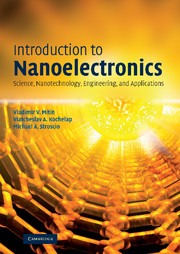Book contents
- Frontmatter
- Contents
- Preface
- List of notation
- 1 Toward the nanoscale
- 2 Particles and waves
- 3 Wave mechanics
- 4 Materials for nanoelectronics
- 5 Growth, fabrication, and measurement techniques for nanostructures
- 6 Electron transport in semiconductors and nanostructures
- 7 Electrons in traditional low-dimensional structures
- 8 Nanostructure devices
- Appendix: tables of units
- Index
Preface
Published online by Cambridge University Press: 05 June 2012
- Frontmatter
- Contents
- Preface
- List of notation
- 1 Toward the nanoscale
- 2 Particles and waves
- 3 Wave mechanics
- 4 Materials for nanoelectronics
- 5 Growth, fabrication, and measurement techniques for nanostructures
- 6 Electron transport in semiconductors and nanostructures
- 7 Electrons in traditional low-dimensional structures
- 8 Nanostructure devices
- Appendix: tables of units
- Index
Summary
Welcome to the amazing nanoworld! In this book you will find fundamental principles in nanoscience and basic techniques of measurement, as well as fabrication and manipulation of matter at the nanoscale. The book discusses how these principles, techniques, and technologies are applied to the newest generation of electronics, known as nanoelectronics.
The science of atoms and simple molecules, and the science of matter from microstructures to larger scales, are both well established. A remaining, extremely important, sizerelated challenge is at the nanoscale – roughly the dimensional scales between 10 and 100 molecular diameters – where the fundamental properties of materials are determined and can be engineered. This field of science – nanoscience – is a broad and interdisciplinary field of emerging research and development.
Nanotechnology is concerned with materials, structures, and systems whose components exhibit novel and significantly modified physical, chemical, and biological properties due to their nanoscale sizes. A principal goal of nanotechnology is to control and exploit these properties in structures and devices at atomic, molecular, and supramolecular levels. To realize this goal, it is essential to learn howto fabricate and use these devices efficiently. Nanotechnology has enjoyed explosive growth in the past few years. In particular, nanofabrication techniques have advanced tremendously in recent years. Obviously, revolutionary changes in the ability to measure, organize, and manipulate matter on the nanoscaleare highly beneficial for electronics with its persistent trend of downscaling devices, components, and integrated systems. In turn, the miniaturization required by electronics is one of the major driving forces for nanoscience and nanotechnology.
- Type
- Chapter
- Information
- Introduction to NanoelectronicsScience, Nanotechnology, Engineering, and Applications, pp. vii - xiPublisher: Cambridge University PressPrint publication year: 2007



